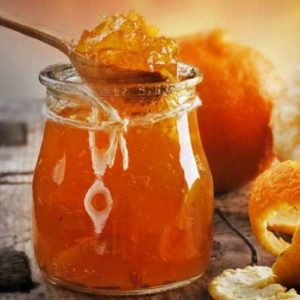
Citrus Marmalade
Ingredients
- 2-pounds oranges, grapefruit or lemons, washed
- 4 cups granulated sugar
- ¼ cup fresh lemon juice
- Add-ins, optional, see note
- Canning jars
Instructions
To prepare the citrus:
- Using a sharp knife, slice off the top and bottom of the citrus so it sits sturdily on the cutting board.
- Slice off the peel and white pith in sections, starting at the top and following the curve of the fruit; you should have a pile of peels and a few naked fruit.
- Thinly slice the peels, with the pith, no thinner than 1/8-inch and no thicker than 1/4-inch, place them in a large bowl; set aside.
- Halve the fruit and remove any visible seeds.
- Thinly slice about 1/4-inch thick, white membrane and all, removing any seeds you might have missed.
- Add the fruit to the peels, and cover with 3 to 5 cups of water, taking note of how much water you used.
- Let this sit for at least 8 hours and up to 24 hours in the refrigerator; this will help extract the pectin slowly as well as soften the peels.
To prepare the marmalade:
- Place a small plate in the refrigerator to chill; to be used later.
- Place the peels, fruit and water in a large pot.
- Add enough water to bring the total to 6 cups and bring to a strong simmer over medium–high heat.
- Cook the citrus until the peels have begun to soften and turn translucent, and the liquid has reduced by about three-fourths; 40 to 50 minutes.
- Add sugar and any add-ins and continue to cook, stirring occasionally at first, then more frequently as the marmalade cooks and the juices thicken.
- Continue until most of the liquid has evaporated and the peels are totally softened and almost completely translucent; another 40 to 50 minutes.
- As the marmalade cooks, the liquid reduces, the sugars thicken and the natural pectins activate.
- You’ll notice the liquid go from a rapid, rolling boil with smaller bubbles to a slow, thick, tarlike boil with larger bubbles; this is the stage at which it’s most important to stir constantly along the bottom of the pot to prevent scorching and sticking; sugar is heavier than water and will concentrate at the bottom of the pot, making the fruit more likely to burn.
- It’s also the stage at which splattering may occur, so take care in stirring.
- When the marmalade reaches this point, add lemon juice and continue to cook, stirring constantly until the jam has returned to its previously thickened state; about another 5 minutes.
- At this stage, the mixture should look thick and viscous with bits of the peel floating around.
- The peels will never break into the liquid as with a jam; this is OK.
- To test the marmalade's thickness, spoon a bit onto the chilled plate, return it to the refrigerator and chill for 2 minutes.
- Drag your finger through it; it should hold its shape on either side without appearing watery or runny.
- If it’s not there yet, cook it for a few more minutes.
- Remove from heat and discard the vanilla bean, if used.
- Divide among jars, leaving 1/4-inch of space at the top, and seal immediately.
Notes
To elevate your marmalade, add in any of these ingredients in Step 7 (How to prepare the marmalade):
- Orange: Add 1 tablespoon freshly grated turmeric; or add 2 tablespoons freshly grated ginger.
- Lemon: Add 1 vanilla bean, split and seeds scraped; or 1 tablespoon earl grey or rooibos tea leaves.
- Grapefruit: Add 2 tablespoons freshly grated ginger; 2 teaspoons rose water; or 2 tablespoons dried Jamaica (a.k.a. hibiscus).